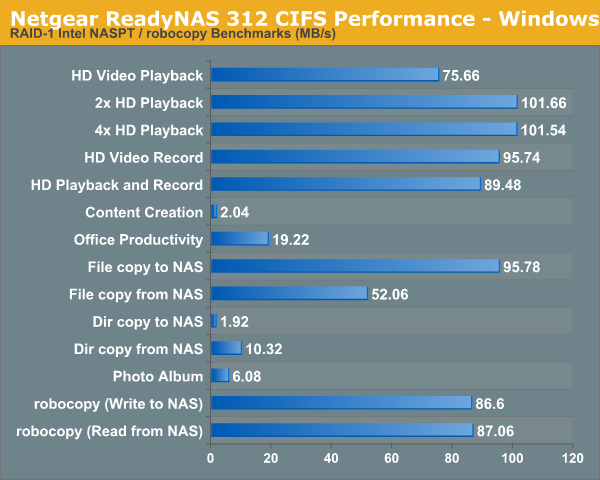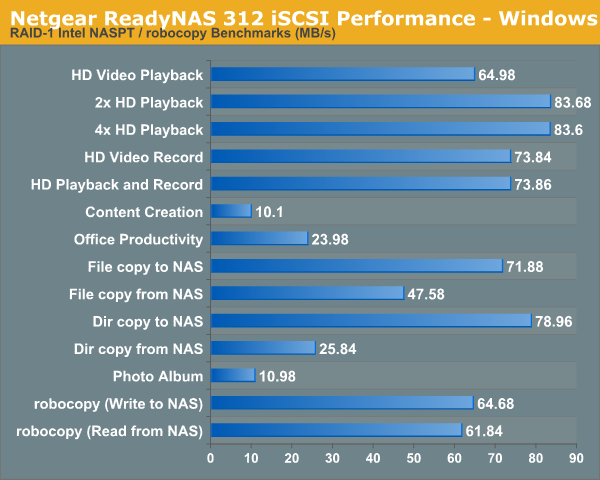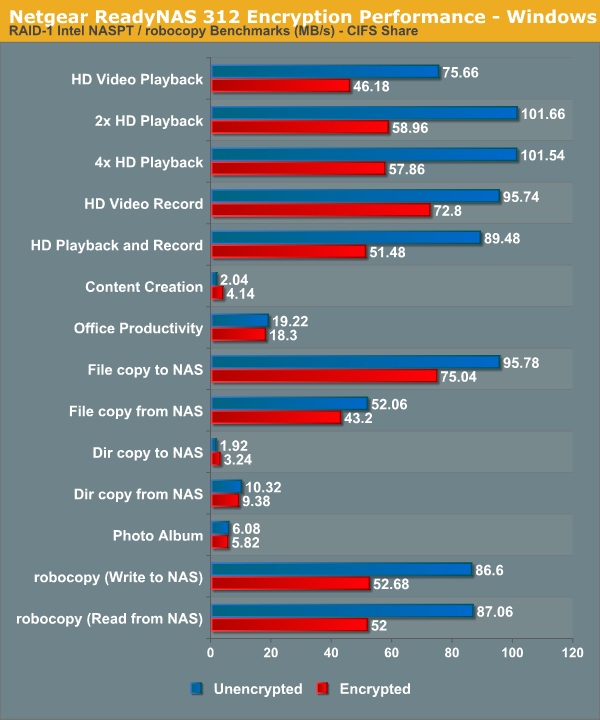Netgear ReadyNAS 312 2-bay SMB / SOHO NAS Review
by Ganesh T S on November 11, 2013 1:00 PM EST- Posted in
- NAS
- IT Computing
- NetGear
- ReadyNAS
Single Client Performance - CIFS and iSCSI on Windows
The single client CIFS performance of the Netgear ReadyNAS 312 was evaluated on the Windows platforms using Intel NASPT and our standard robocopy benchmark. This was run from one of the virtual machines in our NAS testbed. All data for the robocopy benchmark on the client side was put in a RAM disk (created using OSFMount) to ensure that the client's storage system shortcomings wouldn't affect the benchmark results

We created a 250 GB iSCSI target and mapped it on the Windows VM. The same benchmarks were run and the results are presented below.

Encryption Support Evaluation:
Consumers looking for encryption capabilities can opt to encrypt a iSCSI share with TrueCrypt or some in-built encryption mechanism in the client OS. However, if requirements dictate that the data must be shared across multiple users / computers, relying on encryption in the NAS is the best way to move forward. Most NAS vendors use the industry-standard 256-bit AES encryption algorithm. One approach is to encrypt only a particular shared folder while the other approach is to encrypt the full volume. Some NAS vendors have support for both approaches in their firmware, but Netegar only opts for the latter. Details of Netgear's encryption strategy can be found in this forum thread, but the summary is that encryption relies on a key created and stored in a mounted USB drive at the time of volume creation (the volume can't be X-RAID, but has to be set up in a manual RAID level). The USB key needs to be present at boot time for the encrypted volume to be mounted, but, can be removed later. This allows for maximum security, as the encrypted data remains safe even if the unit itself is stolen.
On the hardware side, encryption support can be in the form of specialized hardware blocks in the SoC (common in ARM / PowerPC based NAS units). In x86-based systems, encryption support is dependent on whether the AES-NI instruction is available on the host CPU (not considering units based on the Intel Berryville platform). Unfortunately, the Atom D2701 used in the Netgear ReadyNAS 312 doesn't support AES-NI. However, we are dealing only with a RAID-1 volume. Therefore, impact might not be as brutal as it was seen to be on multi-bay RAID-5-capable NAS units.
We enabled encryption on a volume and created a CIFS share to repeat our Intel NASPT / robocopy benchmarks. The results are presented in the graph below (with the unencrypted volume numbers for comparison purposes).

As expected, encryption carries a bit of a performance hit. In a couple of cases, the numbers seem to even favour the encryption case, but these are within the margin of error for measurements. It goes to show that the bottleneck is on the disk or client side for those cases, rather than the RAID and encryption-related computation on the NAS CPU.










18 Comments
View All Comments
mcfrede - Tuesday, November 12, 2013 - link
Final paragraph states the product name as the "ReadyNSA" am I the only one to find that interpretation hilarious? (sorry for being slightly off topic).ganeshts - Tuesday, November 12, 2013 - link
Thanks for noticing that. I fixed the typo now :)jramskov - Tuesday, November 12, 2013 - link
Using btrf is certainly an interesting choice. It would be nice to see an article that explains the advantages of using it instead of ext4.WilliamG - Wednesday, November 13, 2013 - link
Ganesh, Thanks for the review - just wondering if you know if this unit supports Hyper-V virtual machines via SMB ? I have been trying to find out from Netgear for a couple of days but no one can answer me. Windows 2012 R2 Hyper-V allows the use of SMB 3 file shares to host virtual machine files. Can this unit work for me? thanks in advancewarezme - Thursday, November 14, 2013 - link
To be honest I haven't ever really considered a NAS for storage but if I were, a two bay NAS seems a bit useless to me. So you can do RAID 1 and lose half of your storage or do RAID 0 and gain your space but lose any hopes of recovery if one of your drives dies. Wouldn't a 3 bay NAS be the minimum common sense size?bsd228 - Thursday, November 14, 2013 - link
You don't lose half your storage with Raid1. Unreliable storage has limited value. You keep all of your data if one drive fails, which is a lot better than what happens with a failure on any of those 1 disk NAS units out there. If you want capacity or higher performance, then you get a 4+ disk unit, or roll your own.brian.goodman - Saturday, December 7, 2013 - link
When I had a drive failure on the first drive of the RAID pair in my old ReadyNAS Duo, I learned that the second RAID drive was not accessible, since the ReadyNAS Duo boots from an operating system installed on the first drive. ReadyNAS RAIDar could not even see the NAS, so it was not possible to diagnose the problem through the software interface. Instead I had to decode the blinking lights on the ReadyNAS to deduce that the first drive had failed.Is this still the case in the current generation of ReadyNAS products? In fact is that the case with other NAS products?
Losing the ability to use RAIDar and Frontview was a big surprise and I would have expected that to be flagged in product reviews. What happens after drive failure is not something I have seen reported in any NAS review, but it is very important, as most users expect to be able to access the second RAID drive in case of failure.
Could you add failure mode analysis to your reviews, covering whether the NAS is accessible through software for diagnostic purposes (as against physical inspection of a box), and whether the remaining drives of a multi-drive NAS are actually useable one a failure mode occurs?
Thanks,
Brian